Introduction
An audit is a critical aspect of business operations, serving as a strategic tool to ensure the integrity and security of financial data. To streamline the audit preparation process, it is essential to adopt a layered approach to documentation, organizing information from the most abstract overview down to the granular details. This not only facilitates a clear understanding of operations but also showcases the thoroughness of record-keeping practices.
Gathering relevant documentation, reviewing internal controls, and conducting a risk assessment are key steps in preparing for an audit. Additionally, preparing a schedule, communicating with stakeholders, performing a mock audit, and staying organized are crucial elements of a successful audit preparation. Finally, addressing the auditor's findings and implementing corrective measures are vital for fostering constant progress within an organization.
By following these steps, CFOs can optimize the audit process and strengthen the financial foundation of their organization.
Step 1: Understand the Purpose of the Audit
Understanding the intention behind an audit is paramount for efficient preparation. Whether it's to validate financial compliance, evaluate risk management effectiveness, or assess the performance of operations, each audit type demands a specific set of documentation and insights. For instance, a financial compliance audit will necessitate a comprehensive review of accounting books and adherence to tax regulations, such as reporting foreign bank accounts.
On the other hand, a performance evaluation audit might focus on the operational efficiency and outcomes of the entity.
To streamline your audit preparation, it's beneficial to adopt a layered approach to documentation. By organizing information from the most abstract overview down to the granular details, you provide a structured path for auditors to follow. This not only facilitates a clear understanding of your operations but also showcases the thoroughness of your record-keeping practices.
Amidst the ever-evolving landscape of financial regulations, audits have become a critical aspect of business operations. They serve as a strategic tool to ensure the integrity and security of financial data. By recognizing the specific goals and requirements of your upcoming audit, you can focus your efforts on the most relevant areas, such as internal controls and cybersecurity measures, thereby optimizing the audit process and ultimately strengthening the financial foundation of your organization.
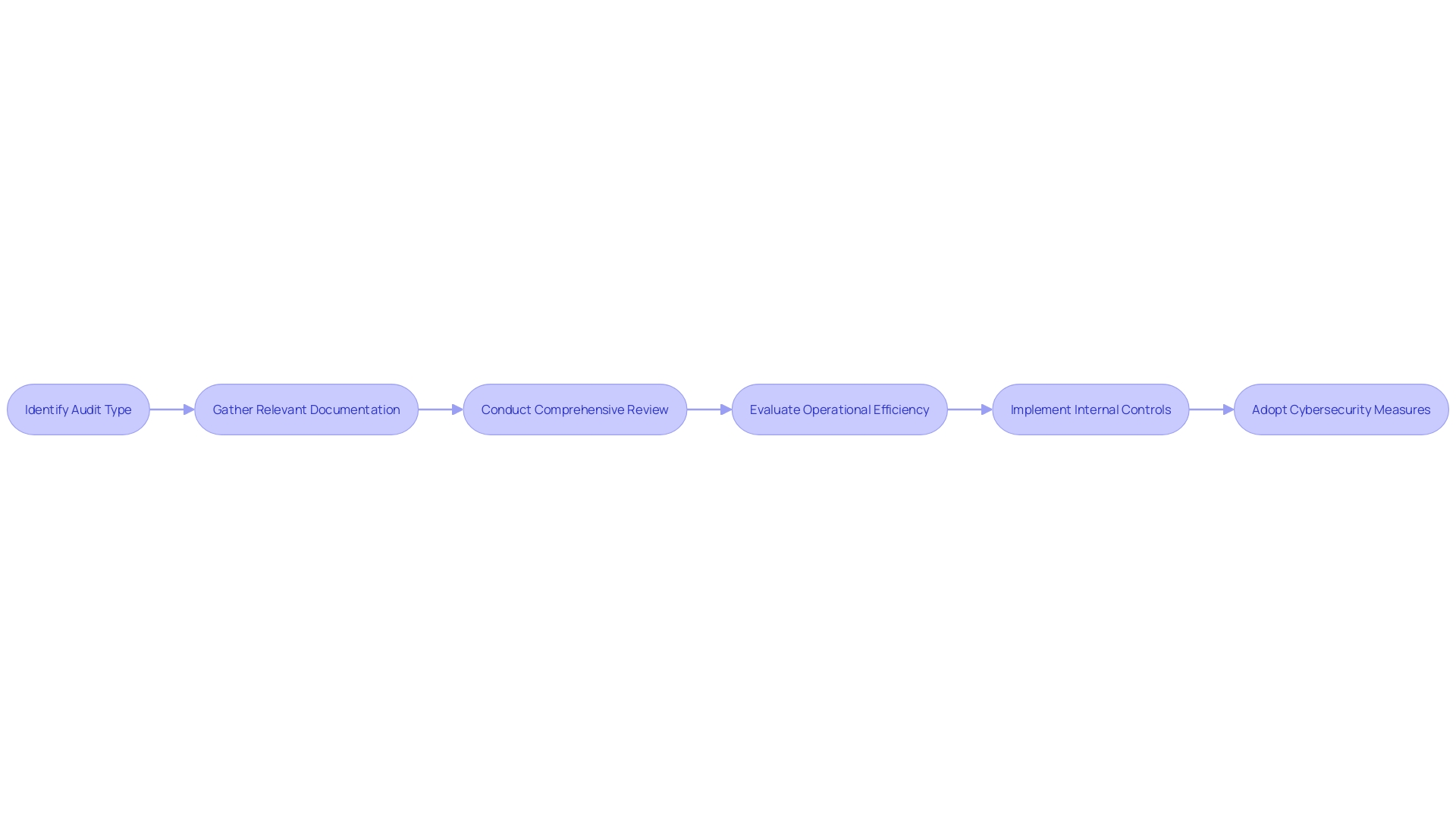
Step 2: Gather Relevant Documentation
As part of a robust audit preparation process, it's crucial to meticulously compile and organize all pertinent records such as financial statements, invoices, receipts, and contracts. This systematic arrangement of documents not only facilitates the auditor's review but also enables them to evaluate the information efficiently. An effective strategy includes implementing a controlled sign-in sheet for attendees, which serves as a record of participation.
Additionally, verifying the credentials of inspectors, like securing a badge and a formal Notice of Inspection, is vital. Presenting a clear overview of the company's workflow and quality policy through a PowerPoint presentation can set a cooperative tone for the inspection. It's imperative to manage the display of information around the facility and label out-of-scope materials appropriately to guide the inspectors' focus.
Moreover, understanding the intricate details of your company's financial reporting needs, such as the accounting principles required, is key to a successful audit. This awareness, combined with the latest standards for onchain audit representations, can significantly enhance the security and compliance of smart contracts, which are fundamental to blockchain ecosystems. It's essential to embrace a proactive and informed approach to audit preparation, ensuring all actions align with the company’s size, scope, and the sensitivity of the data managed.
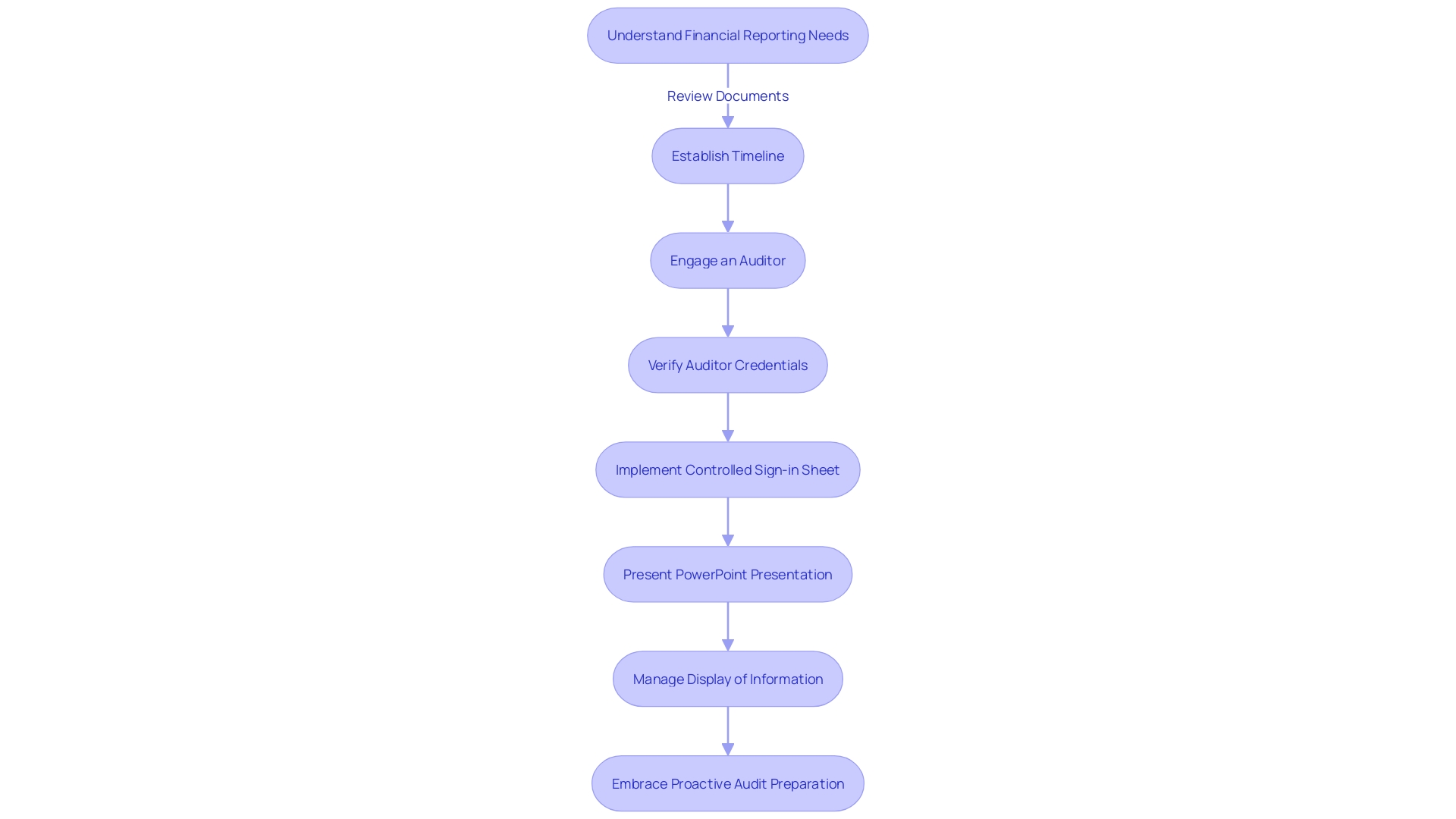
Step 3: Review Internal Controls
To ensure your organization's fiscal health and compliance, it is imperative to rigorously assess and bolster your internal control mechanisms, particularly in anticipation of an audit. A comprehensive evaluation of your control environment is the first step, pinpointing any deficiencies and taking proactive steps to address them. For example, an exercise by Baker Tilly revealed that while technical security controls were strong, there was a need to enhance security awareness among employees to prevent phishing attempts.
This mirrors the importance of not just having controls in place, but also ensuring they are understood and adhered to by all staff members.
Additionally, in line with the FCPA requirements and best practices in compliance, your internal controls must not only exist but also function effectively. Cristina Revelo's insights underscore the necessity to regularly question the frequency and justifications for manual approvals or control overrides, which can signal the need for recalibration of internal controls.
The stakes are high, as illustrated by recent cyberattacks on companies like Schlatter Industries AG, which highlight the consequences of inadequate controls. Furthermore, the Risk in Focus 2024 report emphasizes the global trend towards more robust risk management, urging internal auditors to enhance collaboration with stakeholders and contribute to long-term strategic planning.
In summary, a diligent review and refinement of your internal controls can mitigate risks and align your organization with industry best practices, ensuring preparedness for audits and safeguarding against ever-evolving threats.
Step 4: Conduct a Risk Assessment
Performing a comprehensive risk assessment is integral in pinpointing vulnerabilities within an organization's operations, financial transactions, and systems. This proactive measure is not simply about identifying potential issues but also about crafting robust strategies to mitigate the identified risks. For instance, the catastrophic wildfire risks in California's utility sector highlight the importance of understanding the unique risks faced by a small number of companies dominating a large market.
Similarly, when assessing AI systems, it's crucial to map out use cases and stakeholders thoroughly. The AI Risk Repository, with its extensive database of over 700 unique risks, categorized by cause and domain, serves as a powerful tool for organizations in understanding the multifaceted nature of AI risks.
- According to recent research, organizations recognize the need to review their risk landscape in the face of new technology investments. This evaluation is not just about mitigating threats but also about seizing opportunities that technology disruptors present.
- In the business realm, managing risk is a fundamental function. Sonika Asif from Lush Empires stresses that the decision-making process should first determine the addition to enterprise value and competitive advantage before considering the organization's capability to achieve the set goals.
- The dynamics of risk have shifted dramatically, as evidenced by the rise of supply chain and distribution failures to the sixth position in terms of risk ranking, its highest in over a decade. This increase underscores the interconnectedness of various risks, emphasizing the need for comprehensive assessments that include supplier resilience and diversification strategies.
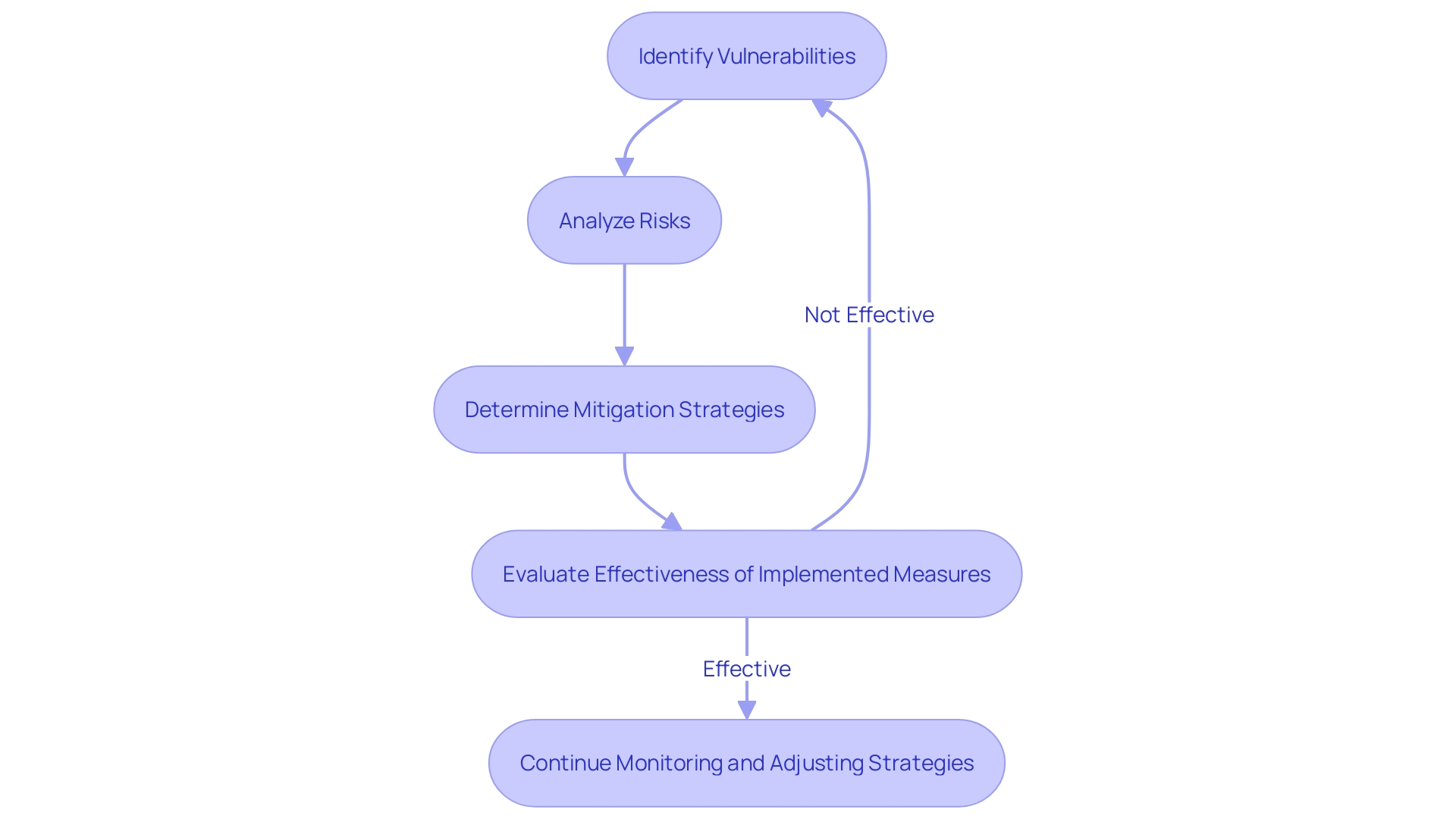
Step 5: Prepare a Schedule and Assign Responsibilities
To effectively prepare for an audit, meticulous planning and a systematic approach are paramount. Begin by mapping out a comprehensive audit preparation timeline that delineates each step of the process with explicit start and end dates. This visual roadmap will act as a strategic guide for your team, ensuring that every task is executed efficiently and on schedule.
Moreover, assigning specific responsibilities to each team member is crucial. Define their roles with precision to set clear expectations, which enables a smooth workflow. This clarity is essential, as it fosters a culture of accountability, similar to the way an IT auditor would rigorously enforce data privacy controls.
Reflecting on the Supplier Security and Privacy Assurance (SSPA) program, where suppliers to Microsoft must regularly prove adherence to stringent data protection standards, we can also see the importance of a well-defined Data Processing Profile (DPP). Likewise, in your audit preparation, having a well-crafted, written set of success criteria is invaluable. These should be comprehensive, minimal, written, and falsifiable, to serve as a concrete benchmark for the audit's successful outcome.
Incorporating these elements into your audit preparation schedule not only streamlines the process but also significantly enhances the reliability of the audit results. By doing so, you'll be aligning with best practices that prioritize operational efficiency, compliance, and risk management—key areas scrutinized during financial statement audits and information security assessments.

Step 6: Communicate with Stakeholders
As you embark on the audit preparation phase, it's crucial to establish a robust communication strategy that encompasses all pertinent stakeholders. By proactively involving key individuals, you will ensure that everyone is aligned with the audit's timeline, objectives, and their specific responsibilities. This is not just about relaying information but also about fostering a collaborative environment.
Engaging with departments such as finance, legal, and operations is essential for the successful gathering of all required documentation and preemptively addressing any concerns that may arise.
Drawing inspiration from Nets, a provider of digital payment solutions, who transformed technical data into accessible formats, consider employing visual aids that simplify complex information and aid in stakeholder comprehension. As Nets discovered, presenting technical data in a way that stakeholders find engaging promotes proactive exploration and understanding.
In line with strategies suggested by members of the Forbes Finance Council, it's beneficial to tailor your communication to the unique interests and expectations of different stakeholders. Avoid using jargon and overly technical language that might obscure your message. Instead, use clear, compelling narratives supported by visual representations like charts and graphs to articulate complex financial data effectively.
Remember, the essence of an effective audit preparation lies in the clarity and simplicity of your strategy, as emphasized by Oluwatoyin Aralepo from the MasterCard Foundation. The financial performance and strategy of your company should be communicated in a way that reflects the core priorities, whether that's margin over volume or another strategic focus.
To ensure your communication strategy is successful, consider creating a stakeholder map to identify and prioritize individuals based on their influence and interest. This will serve as a guide for your team, facilitating a strategic approach to stakeholder engagement. This approach, coupled with a keen understanding of your entity's financial reporting needs and the appropriate accounting principles, will pave the way for a smooth and effective audit process.
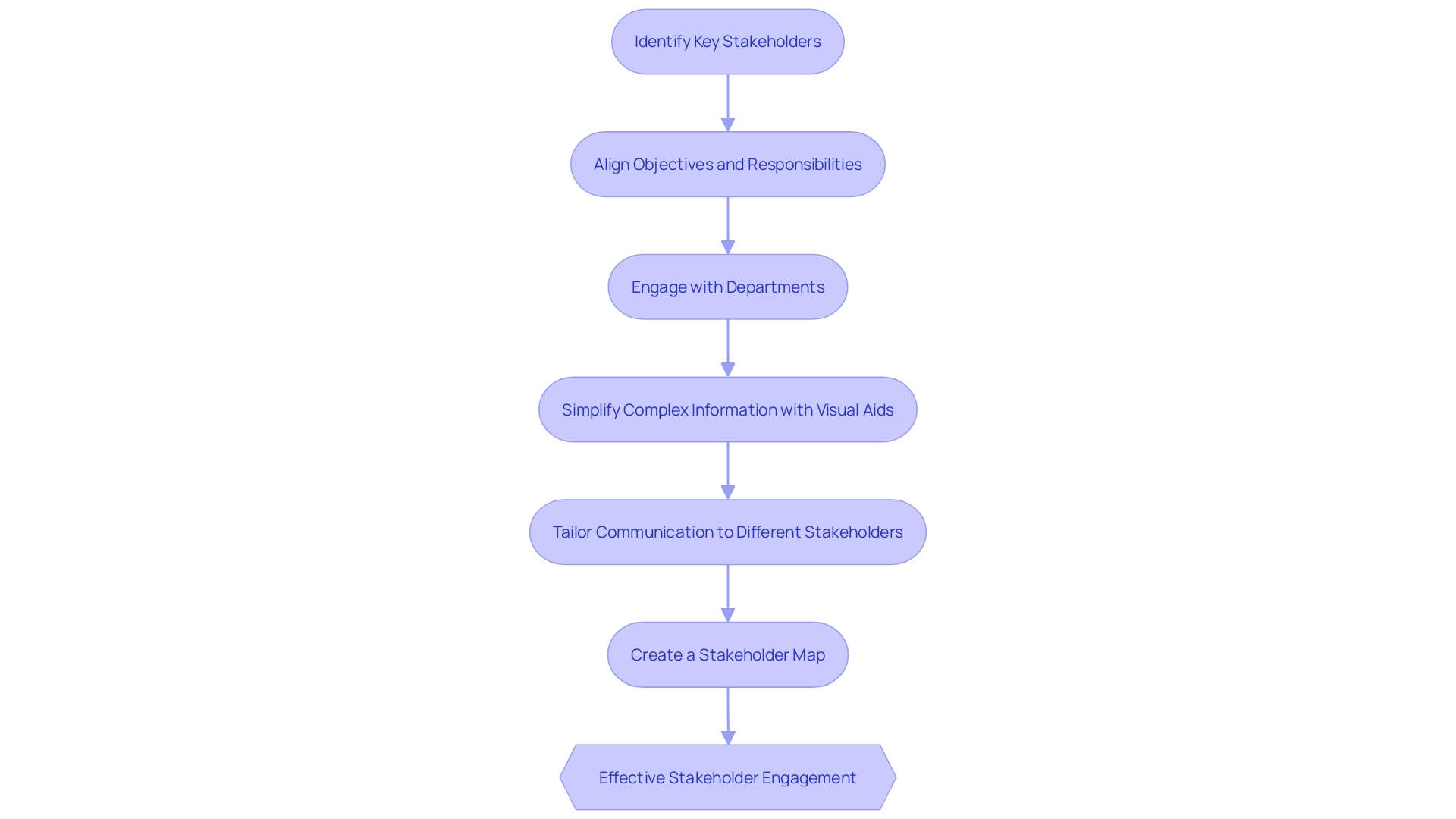
Step 7: Perform a Mock Audit
Engaging in a mock audit not only sheds light on areas requiring improvement but also primes your team for the real audit experience. By simulating the process, potential deficiencies in preparation are unearthed, allowing for timely enhancements. This proactive approach is akin to conducting a rehearsal, ensuring that when the time comes, your team navigates the audit with reduced stress and increased efficiency.
It's essential to grasp that an audit's essence is to evaluate the robustness of security measures, pinpoint weaknesses, and confirm adherence to relevant statutes and standards. In the domain of InfoSec and Cybersecurity, audits are indispensable in preserving the integrity, confidentiality, and availability of critical data. With a variety of audit types at play, from internal audits focusing on internal controls, policies, and procedures to comprehensive external assessments, each serves a pivotal role in fortifying an organization's defenses.
Consider the insights from recent industry practices where Monte Carlo Simulations are employed to gauge the completion timeline of features, particularly useful for products with infrequent release cycles due to their critical infrastructure role. This data-driven tactic exemplifies the value of innovative approaches in audit preparation and execution. Furthermore, the integration of automated audits and unit tests highlights the advancement in detecting the most conspicuous issues, ensuring that no stone is left unturned during the audit process.
Contemporary audit reports are thorough, detailing the project's intricacies and the status of identified issues, whether resolved or not. This meticulousness is a testament to the audit's significance, reinforcing the necessity of a systematic and comprehensive evaluation for the assurance of an organization's cyber and information security.
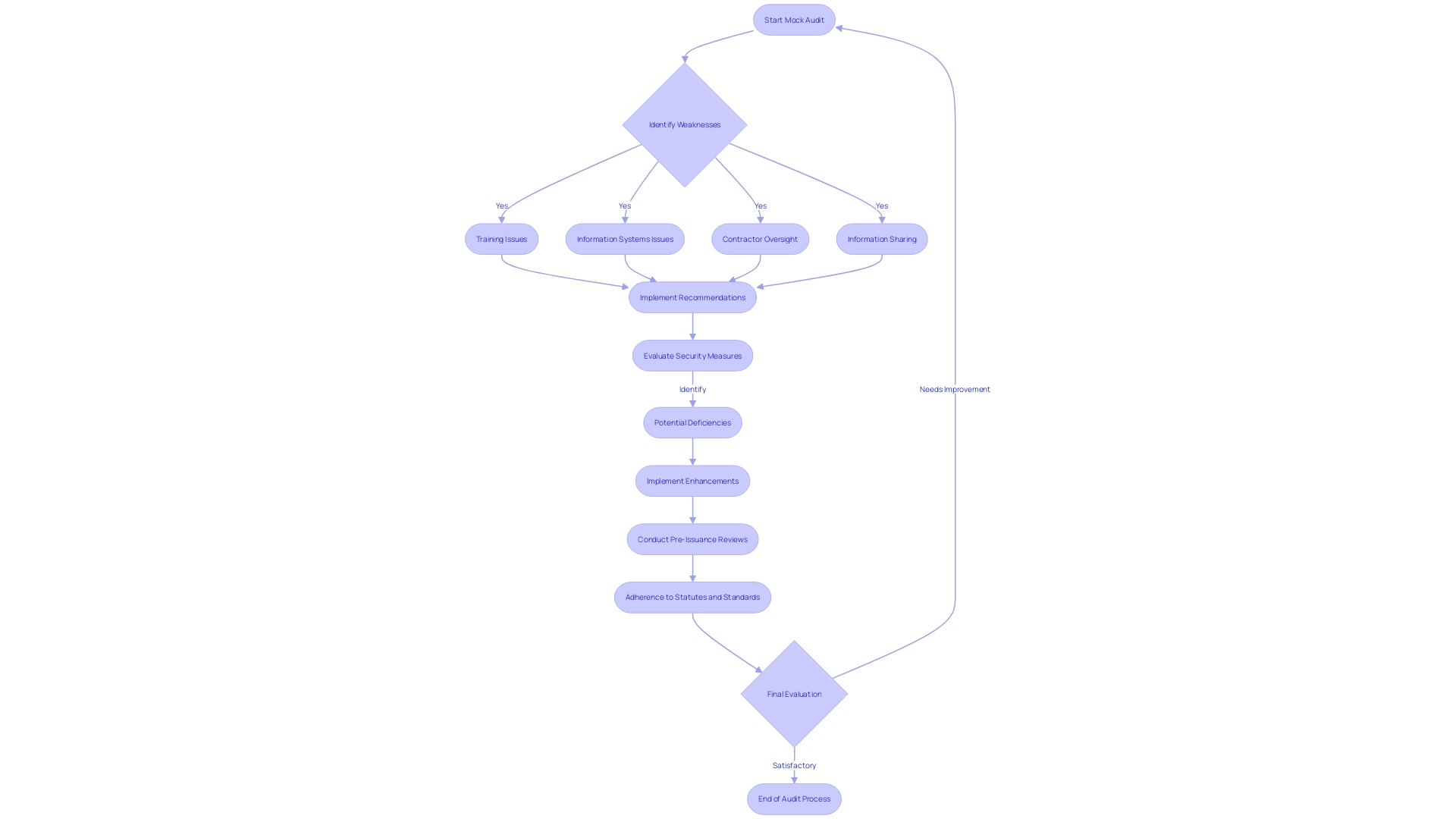
Step 8: Stay Organized and Maintain Documentation
Ensuring a streamlined audit process requires meticulous organization and systematic documentation. It's imperative to have all pertinent records readily accessible, ideally consolidated in a single, secure location. This practice not only facilitates your team's efficiency but also simplifies the auditors' task, leading to a smoother audit experience.
It's essential to continually monitor the progress against the audit preparation timeline, making adjustments as necessary to address any emerging tasks.
ISO 27001, a leading global standard for Information Security Management Systems (ISMS), underscores the importance of an organized framework for safeguarding information assets. This standard is built around a comprehensive approach that includes evaluating personnel, policies, and technological systems, thereby enhancing the overall integrity and confidentiality of data. The implementation of an ISMS is a strategic move to manage risks effectively, bolster cyber resilience, and strive for operational excellence.
Furthermore, recent findings from the Department of Justice's Office of the Inspector General highlight the criticality of robust procedures in tracking and securing sensitive information. The audit identified significant deficiencies in the FBI's inventory management and disposal of electronic storage media, underscoring the urgency for organizations to enhance their documentation and organizational strategies.
The Ford Foundation's digital revamp, spearheaded by Bedirhan Cinar, exemplifies the transformative power of well-structured documentation. By adopting a layered approach that guides the reader from a high-level overview to the intricacies of the content, organizations can achieve greater clarity and comprehension among stakeholders.
To this end, a profound understanding of one's financial reporting requirements and deadlines, as well as the selected accounting principles, is paramount. Whether adhering to GAAP or another comprehensive basis, such as the income tax basis of accounting, this knowledge forms the backbone of an efficient audit process. As you prepare for your audit, remember that well-organized documentation is not just a formality; it is the lens through which auditors and stakeholders alike will perceive and understand your financial landscape.
Step 9: Address Auditor's Findings
Once an audit is concluded, the pivotal next steps involve a meticulous review of the findings and the swift implementation of corrective measures. Crafting a strategic action plan to ameliorate identified deficiencies is critical. This includes fortifying internal controls and refining procedures guided by the audit results, thereby fostering an environment of constant progress within your entity.
For instance, after the Federal Aviation Administration's comprehensive six-week review of Boeing's 737 Max manufacturing processes, significant lapses in compliance with production standards were uncovered. This led to Boeing's prompt response, instituting weekly compliance checks and reinforcing adherence to protocols, showcasing the importance of immediate and structured remediation post-audit.
Similarly, the Canadian Public Accountability Board's audit of one of the Big Four firms revealed recurrent significant findings. The firm's commitment to re-evaluate and enhance its audit procedures reflects the essential nature of addressing audit outcomes decisively.
Organizations like the Ford Foundation and the Somerset Academies of Texas have also demonstrated the value of responding proactively to audit insights. The Ford Foundation revamped their content management system to better meet the needs of their audience, while Somerset Academies integrated their disparate software systems for improved operational efficiency.
The essence of these actions lies in the recognition that audits, while a snapshot in time, can have far-reaching implications for information security and the overall robustness of an organization's processes. As such, it is imperative to not only identify but to execute on opportunities for improvement, thereby ensuring data integrity, safeguarding sensitive information, and ultimately, driving organizational excellence.
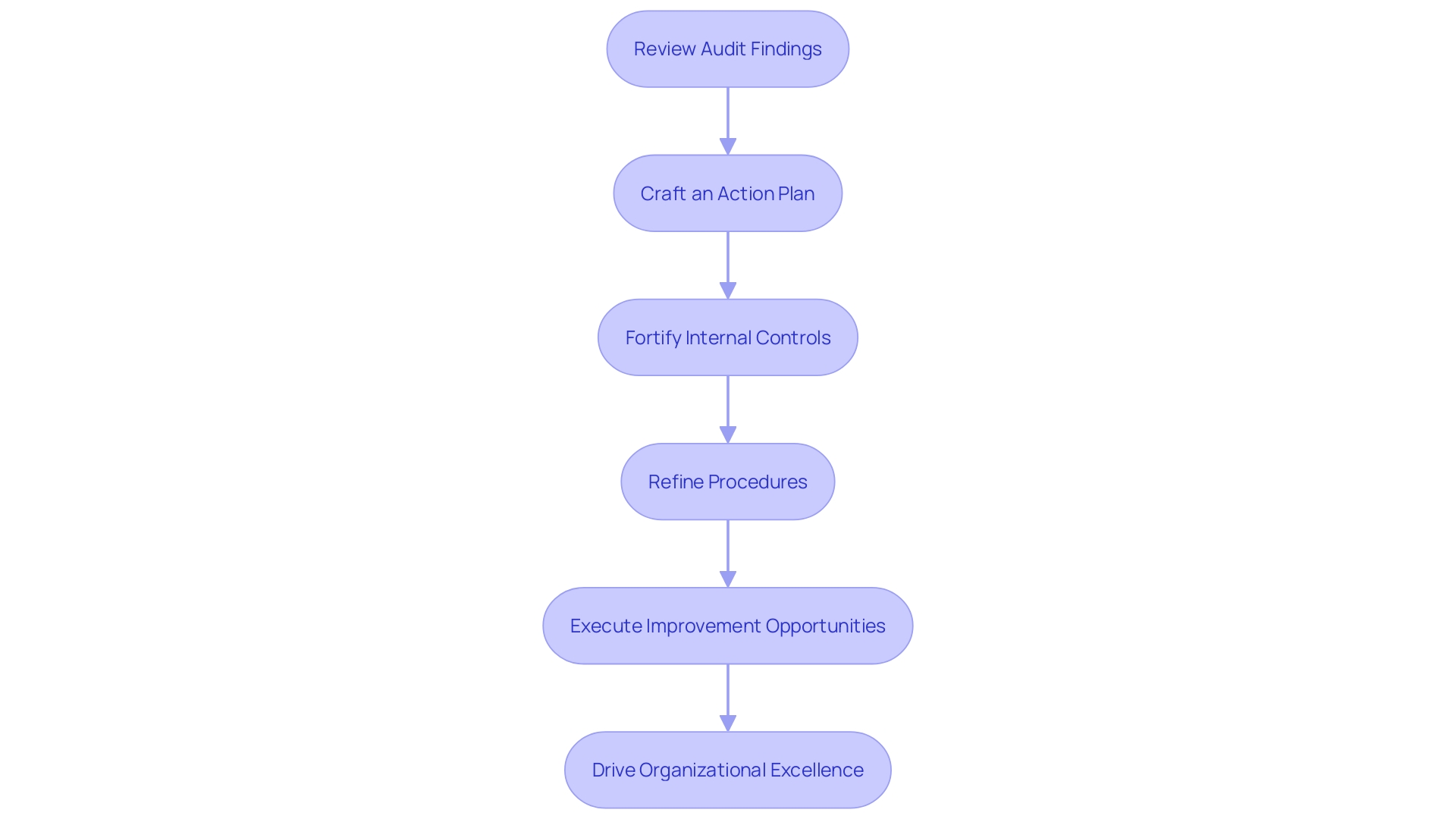
Conclusion
In conclusion, adopting a layered approach to documentation, understanding the purpose of the audit, and gathering relevant documentation are crucial for efficient preparation. Reviewing internal controls, conducting a risk assessment, and preparing a schedule with assigned responsibilities streamline the process.
Effective communication with stakeholders, engaging in a mock audit, and maintaining organized documentation enhance efficiency. Addressing the auditor's findings and implementing corrective measures drive constant progress.
By following these steps, CFOs can optimize the audit process, strengthen their organization's financial foundation, and ensure data integrity and organizational excellence.




